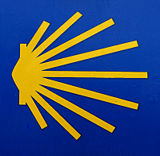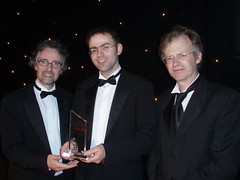24 May 2008
Camino-Waterford (May 2008)

Over the past two weeks I have travelled on the Camino Santiago (the way of St James) from Waterford to Santiago de Compostela, in Galicia, Spain. The route involved sailing on board the Jeanie Johnston (a replica 19th century wooden hulled sailing ship --- as close to medieval as we could get) from Waterford quay, out of the Waterford estuary, and the southwards past the Scilly Isles and across the Bay of Biscay to A Coruña on the north coast of Galicia; this was a journey of 4 days. The next section was on foot from A Coruña to Santiago de Compostela over 3 days. Finally we spent a few days in Santiago before flying back a more conventional twenty first century route to Dublin airport.
The journey was a recreation of the pilgrimage taken by a previous Mayor of Waterford City in 1473 and 1483, James Rice. This route was known in Medieval times as the "English Way", which was an alternative to the more famous land routes to Santiago such as the French routes that cross the Pyrenees and converge near Pamplona, or the internal Iberian (Spanish and Portuguese) routes coming from the south.
I have posted three sets of public photographs (as yet undocumented) on the Flickr photo sharing site, and I've made this available to everyone so that the people I travelled with can have easy access to them:
- Camino-Waterford Preamble (a small number of photographs taken on my camera phone during and after the ceremony in Christ Church Cathedral where Mary O'Halloran, the Mayor of Waterford, sent us on our way)
- Camino-Waterford Voyage (photographs taken with my Cannon 400D SLR with a Sigma 30mm F1.4 EX DC prime lens)
- Camino-Waterford Walk (photographs taken with my Cannon 400D SLR with a Sigma 30mm F1.4 EX DC prime lens)
I found the camino to a be a fantastic experience, particularly because of the people who we travelled with on the ship, and on foot. So a big thanks to my fellow pilgrims: Eamonn, John (of the shell), Jackie, Nina, Mary, Anne, Paddy, Pat, Jim, Oliver, Brian, Aidan and Tim; a big thanks to our fellow travellers on the ship: Sean, John, Pat, Maeve, Coleman, Stephen and Steve; a big thanks to the captain, officers and crew of the Jeanie Johnston (the captain, Luca, Paul, Daithi, , Quentin, Jim, Charlie, Suzie, Earl, Karen, Pat and Johnnie). The trip was organised by the Waterford Museum of Treasures, who placed this article (worth reading for some historical background on James Rice who made the pilgrimage in 1473 and 1483) in the local newspaper the Munster Express; so a special thanks to Eamonn and Donnchadh for making it all possible.
References
- Edwin Mullins, 1974, The Pilgrimage to Santiago (the best book I have found about the pilgrimage which, though it focuses on the route from Paris over land, covers much of the history and context for the growth and decline in popularity of the pilgrimage).
- Camino de Santiago A practical blog about doing the walking pilgrimage today.
7 May 2008
TSSG spin-out Zolk C wins prestigious museums award
In London on Wednesday 7th May 2008 the National Trust for Scotland was presented with an a Museums & Heritage Award (full list of awards) for "Use of Technology" in its Culloden site. This recognised the innovative use of technology, a GPS PDA system that delivers an integrated multimedia audio, video and text guide to visitors to the Culloden Battlefield site near Inverness in Scotland. This solution was developed by the TSSG spin-out joint venture company Zolk C together with content management experts.
Edited Wikipedia entry on Battle of Culloden
The Battle of Culloden (Scotts Gaelic: Blàr Chùil Lodair--most of the Highlanders would have spoken Scotts Gaelic), 16 April 1746, was the final clash between the Jacobites and the British Government in the 1745 Jacobite Rising. Culloden brought the Jacobite cause--to restore the House of Stuart to the throne of the Kingdom of Great Britain--to a decisive defeat.
The Jacobites--the majority of them Highland Scots, although containing significant numbers of Lowland forces--supported the claim of James Francis Edward Stuart (aka "The Old Pretender") to the throne; the government army, under the Duke of Cumberland, younger son of the Hanoverian sovereign, King George II, supported his father's cause. It too included significant numbers of Highland Scots, as well as Scottish Lowlanders and some English troops.
The aftermath of the battle was brutal and earned the victorious general the name "Butcher" Cumberland. Charles Edward Stuart eventually left Britain and went to Rome, never to attempt to take the throne again. Civil penalties were also severe. New laws attacked the Highlanders' clan system, and Highland dress was outlawed.
The picture shows myself, Paul Savage and Eamonn de Leastar, the TSSG members who were present at the award ceremony. No blood was spilled, though kilts were in evidence. A big thank you to the full team who made the award possible, including all those in the TSSG who helped.
- Zolk C (at present home page has pictures of the full Zolk C team, including myself)
- TSSG
- Culloden Battlefield
- Museums & Heritage Show
2 May 2008
FeedHenry partner with Oracle
SiliconRepublic.com: Irish firm at spearhead of Oracle’s Web 2.0 plans
The TSSG spin-out company FeedHenry has partnered with Oracle. They're starting to gain some traction in the market, and we see a bright future for the dynamic mix of service development platform with legacy interfaces and lightweight widget-based scripting allowing easy creation of Web 2.0 mash-ups. This is particularly attractive to telecommunications operators who are tying to keep up with developments in communications services creation environments.
